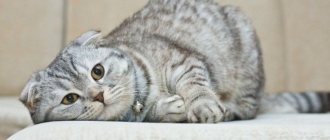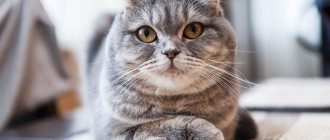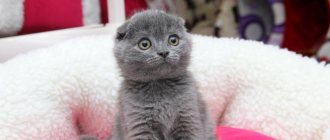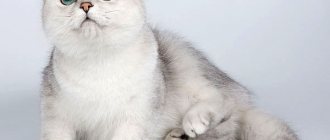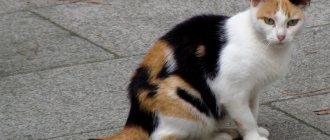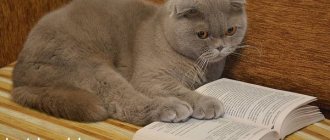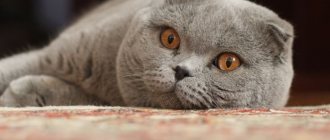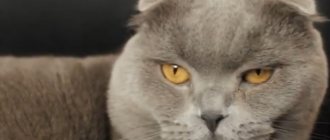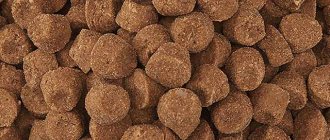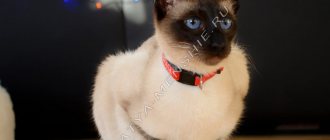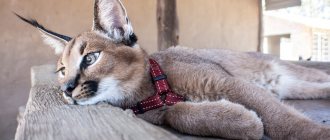9027Administration
Along with nutrition, caring for a Scottish Fold kitten and its proper organization is one of the first places in importance. This is necessary to ensure that your Scottish kitten always remains healthy, playful and does not need additional veterinary care.
Care consists of proper nutrition, organization of sleeping space, availability of necessary toys and scratching posts, as well as a timely cleaned toilet with the correct filling. If all these requirements are met, caring for a Scottish kitten will not take much of your time , he will know which territory is his own and will not be mischievous in the house.
On a note
Owners of this breed note that the Scottish cat is quite calm and balanced and can spoil or do some kind of mischief only if the owners do not adhere to a sufficient level of cleanliness and care and do not provide everything necessary for the pet’s life.
© shutterstock
An integral part of the care is also a planned, independent examination of the ears and eyes, timely trimming of nails and comprehensive care for the pet’s coat, as well as a visit to the veterinarian for vaccination and carrying out all necessary procedures according to the schedule.
Organizing a personal space for a kitten
In order to understand how to care for a Scottish cat, you need to study a little about its character and basic habits that are inherent in all representatives of the Scottish breed. Scottish cats are quite clean and not picky about grooming , but they require that everything they need is always within reach and the Scottish cat must have its own place. Where he could hide and be alone with himself.
Scottish cats are quite undemanding in terms of attention and care, they are mostly left to their own devices, they are perfect for those who are often not at home, but who want to be greeted by their beloved Scottish kitten, without suffering from a lack of attention and care due to the dense owner's work schedule. The main requirements that must be met in care are:
- availability of a clean toilet;
- timely and proper nutrition;
- having your own bed;
- scratching post
History of the Scottish Fold breed
The first mention of cats with curled ears dates back to 1796. An English sailor brought such an animal from China. However, nothing is known about his further fate. The ancestor of the modern Scottish Fold breed is the cat Susie, who was born in Scotland in 1961 from an ordinary cat. One of her fold-eared kittens, a girl named Snooks, was given to breeders. They began closely breeding the breed and during experiments discovered that only some kittens are born with fold ears, while the rest are born with ordinary, straight ears. It was also found that recumbent ears are the result of a gene mutation that is inherited by kittens in a dominant manner.
Cat Susie - the progenitor of the Scottish Fold breed
When two fold-eared individuals mated, unhealthy kittens were born with defects in the structure of the musculoskeletal system, for example, with fusion of the vertebrae, especially often in the caudal region. Therefore, the felinological organization GCCF decided to stop breeding the breed in the UK.
Attempts to fix the lop ear gene and produce healthy offspring continued in the USA. Breeders have tried breeding cats with curved and straight ears. Representatives of British, exotic and American breeds were used as partners. The litter contained healthy kittens, some of which had distinctive ears. The breed was officially recognized by the CFA in 1976.
At the same time, European breeders continued to work on improving the breed. They did not breed Scottish Folds with straight-eared ones, but used British cats as partners. So the Scottish Folds received the external characteristics of the British - a dense thick plush coat, powerful bones and a massive physique. In Russia, cats began to be bred only in the 90s of the last century.
There is a misconception about the existence of a breed of British Fold cats. The British can only have straight ears, but the Scots have both standard (Scottish Straight) and curled (Scottish Fold) ears. Moreover, the former are much inferior to the latter in price.
Organization of a toilet for a Scottish kitten
Considering that representatives of this breed are quite clean, proper care includes timely replacement of litter and its correct choice. The most optimal option is to use the litter that was in the nursery, so the Scottish kitten will not have to adapt and will quickly adapt to the new place of residence and toilet. And the character of Folds is such that he can shit or go to the toilet in the wrong place only if he does not find his own tray or the toilet was not cleaned on time.
If a Scottish kitten went to the toilet in the wrong place, under no circumstances should you punish it, as this will be regarded solely as aggression and will not lead to any results.
In this case, it is recommended to thoroughly clean the place where the kitten went to the toilet and additionally show him where the tray is so that he can find it on his own next time.
© shutterstock
Vaccination
The comprehensive cat vaccine includes three main infectious diseases - panleukopenia (feline distemper), calcivirosis and rhinotracheitis (herpes virus), as well as a fatal disease - rabies. Vaccines that include chlamydia and viral leukemia are also available upon request.
Types of vaccines
For the first time in life, viral diseases are vaccinated twice, with an interval of 21 days. Infections can be vaccinated starting at 8 weeks of age. After a double vaccination, vaccination is carried out once a year, along with rabies. The first time the rabies vaccine is given is at three months, and then once a year.
Important! Even those animals that live in an apartment and do not go outside need to be vaccinated. The infection can easily be brought on by shoes. All viral diseases of cats have a very high mortality rate.
If the cat has never been wormed in its life, then it is better to do it 10 days before vaccination. If, after giving an anthelmintic, vomiting, diarrhea or worms in the feces appear, the treatment against parasites should be repeated and the vaccination should be delayed. In general, an anthelmintic drug should be given once every 3-4 months.
Scratching post and toys
Mandatory care attributes that any Scottish kitten should have are:
- one or two scratching posts that will allow you to sharpen your claws and clean them in a timely manner - as the basis of care;
- various types of toys in the form of balls, mice, fishing rods with feathers and other entertaining toys that you and your pet will enjoy.
Having these toys will not only amuse your animal, but will also allow him to have fun while you are away. And if you wish, you can always play with your pet without thinking about where to get a ribbon for playing or a candy wrapper in order to attract a Scottish kitten.
© shutterstock
Feeding in the first year of life
Like kittens of other breeds, Scottish kittens consume only mother's milk up to 3 weeks. If an accident occurs, for example, a Scottish cat died during childbirth, from a malignant disease or due to accidental poisoning, or ran out onto the roadway, refused to feed the kittens, or other accidents, then orphaned kittens will benefit from milk formulas that are extremely close in composition to cat milk.
Good products are produced, for example, by Royal Canin, which specializes mainly in dog and cat food. Manufacturers of such products ensure that the fat content does not exceed 10%, and the vitamin content of the compositions is sufficient for the growing body of dogs and cats.
If there is no specialized store or veterinary hospital with a mini-store nearby where you can choose food for any kittens and puppies, act independently. To reduce the fat content, village (farm) milk is diluted in half with boiled water or cleared of cream and given to a newborn kitten to taste. They begin to feed it off, gradually reducing the number of meals per day from day to day, but increasing the volume of each complementary food.
You can take the nutrition of any average outbred kitten as a basis - all kittens consume approximately the same amount of milk. A specific breed - the same Scottish cats - requires its own amount of food in the first days and weeks of life, but you can save the life of your ward and let him grow up, adhering to the norm of “street” kittens.
Carrying out hygiene procedures
Organization of special care for Scottish Fold kittens includes:
- timely bathing;
- cleaning and examining the eyes and ears;
- cleaning and cutting nails;
- mustache and coat care.
British Fold kittens especially need careful care. First of all, these are regular hygiene procedures, examination of the ears and care for them.
Considering the specific structure of the ear, special attention is paid to their cleaning, care and timely hygiene. And in order to clean the ear, you need to unscrew it and wipe it with a damp swab on the auricle.
If light-colored, odorless sulfur remains on the swab, then your Scottish kitten is completely healthy. If, when examining the ears, an unpleasant, specific odor appears, the wax turns yellowish, this indicates the presence of an infectious disease that requires urgent diagnosis and treatment by a veterinarian or insufficient care.
Eye hygiene
The anatomy of Scottish cats provides for a high risk of infection of the tear duct, therefore it is necessary to pay special attention to the hygiene and care of your kitten's eyes . Very often, owners of Scottish cats consider it normal for this breed to have a tear streak from the eye. However, this approach is not correct, since purulent or brown discharge from the tear duct signals that you urgently need to contact a veterinarian and clean the tear duct, because the main cause of such discharge may be infection or improper care.
It is recommended to wipe the eye from the corner and along the inner edge with a damp swab weekly, and if desired, you can purchase a special liquid for eye hygiene and care. It is also imperative to inspect the eyes every morning and, if a dark coating forms, remove it with a regular sponge.
These simple rules will help keep your pet healthy and avoid visiting the veterinarian.
Weight gain chart
Scottish kitten weight table by month
| Age | Female weight (kg) | Male weight (kg) |
| 1 month | 0,3-0,6 | 0,45-0,7 |
| 2 months | 0,45-0,76 | 0,85-1,6 |
| 3 months | 1,25-1,65 | 1,35-2,4 |
| 4 months | 1,74-2,35 | 2-3,7 |
| 5 months | 2,25-3,1 | 2,45-4,19 |
| 6 months | 2,36-3,57 | 3-5,56 |
| 8 months | 2,9-4,26 | 3,45-6 |
| 10 months | 3,1-4,63 | 4,2-7,1 |
| 1 year | 3,2-5,35 | 4,6-7,35 |
| 2 years | 3,42-5,65 | 5,4-8,1 |
Thus, the weight table for Scottish kittens shows the approximate rate of weight gain. A kitten at 2 months is approaching 1 kg, while a Scottish kitten at 3 months weighs about one and a half. During this period, their appetite is very good, babies eat everything offered and wash it down with mother's milk.
The weight of a 2 month old kitten increases every day. At 4 months your kitten’s weight is already the same as that of an adult; at 5 months it reaches an average of 3-4 kilograms. After which the grown-up cat does not gain weight so quickly.
A Scottish kitten at 4 months is ahead of its peers of other breeds, for example, Siamese. At 7 months, cats grow to five-kilogram animals. At 9 months and cats weigh more than 4 kg. An average measurement at 1 year shows that the weight of an adult male cat is 5-6.5 kg, and a female cat is 4.5 kg.
By the age of two, the animal becomes more imposing and adds another kilo to its weight. But if a two-year-old weighs 3 kg, this is not a reason to be upset, if the pet looks healthy, perhaps this is its genetic feature.
Nail hygiene
You should trim your pet's nails about once or twice a month. Particular attention should be paid to avoid damaging the blood vessel while caring for your nails. For this Scottish kitten, it is recommended that he be taught to trim his nails and care for them from childhood so that he does not resist or interfere with the owner when carrying out these hygiene procedures and caring for his paws.
© shutterstock
To cut nails, it is recommended to purchase specialized scissors, which are sold in zoological stores. Also an important step in cleaning, hygiene and care of nails is the use of a scratching post, which is recommended to accustom a kitten to from a very young age.
Using a scratching post is not only fun for a kitten, but also a healthy necessity, since claws need to be renewed and sharpened - this is one of the aspects of caring for them.
Bathing a fold cat
Like any other cats, Scottish Folds do not like water. But if you teach a kitten to bathe from childhood, in the future he will not resist the procedure much.
In order to minimize stress when a cat comes into contact with water, you need to adhere to the following rules:
- Trimming the nails will protect the owner's skin if the Scotsie begins to resist bathing. In some cases, thick wristbands are additionally put on the hands, which protect the wrists from deep scratches.
- A degreasing composition is applied to dry wool. These could be dry shampoos, gels or other similar hygiene products for cats.
- Leave the composition on the surface of the cat's coat according to the manufacturer's recommendations, and then wash it off with plenty of running water.
- Then apply the main shampoo to the wet coat and rub it all over the body until a thick foam forms. The operation, depending on the degree of contamination, can be repeated several times.
- Rinse off the shampoo and apply conditioner. It covers the hair follicles, improves the hair structure and gives it a silky texture.
After bathing, the cat should be wrapped in a towel and the fur should be dried thoroughly. At this time, the pet should be in a warm room without drafts.
Oral care
Considering that the bone and cartilage tissue of British kittens is quite fragile, it is necessary to pay special attention to the oral cavity and its care. Dental care includes regular checkups and cleaning, if necessary, to remove tartar and plaque. It is recommended to independently examine the oral cavity and teeth once a month . They should be white, without any inclusions, and the gums should be uniformly pink.
In case any wounds are found in the mouth, it is recommended to immediately contact a veterinarian who can correctly diagnose them and prescribe treatment. In this case, it is recommended to switch the British kitten completely to soft food and exclude solid food until complete recovery.
Sample menu by age
A sample menu by age will help you assess your ability to care for your future pet. The recommendations below are not clear instructions; always rely on the rate of development, growth and weight gain of your pet.
Important! To adequately assess the diet, weigh the kitten regularly. Sudden changes in weight will tell you how and when to adjust the menu.
Menu for a kitten up to a month
Up to a month, kittens feed only on mother's milk. If the baby is orphaned, he needs to be artificially fed.
Grooming
Considering the innate cleanliness of British cats, to care for their fur you will need to organize a whole ritual, which will include:
- bathing;
- combing;
- the use of special lotions.
Considering that cats of this breed have a fairly thick undercoat, it is not recommended for them to lick themselves, as the fur easily becomes matted and can clog the intestinal tract. In this regard, it is necessary from childhood to accustom kittens to regular water procedures, as well as combing after them, especially if they have long and beautiful hair.
note
Steady and constant growth is a key component in the proper development of a kitten. In the first days of life, still helpless kittens should, on average, gain about half an ounce of weight (15 grams) each day.
If they grow with such results, then we can assume that they are completely healthy. However, don't panic if your kitten stops gaining weight for a day or two. Quite often, kittens experience short-term weight stabilization, after which accelerated weight gain resumes.
https://www.purinaone.ru/cat/catmag/adoption-rescue/the-weight-of-the-kittens
https://petstime.ru/article/ves-kotenka-po-mesyacam-ot-rozhdeniya-do-goda
Adaptations
Brushes for combing are:
- wooden and plastic;
- with wide teeth or natural bristles;
- in the form of a comb or in the form of a glove.
For short-haired cats, weekly brushing with a special brush, which consists of natural bristles, is acceptable. Based on your pet's preferences, you can use a plastic or wooden brush with wide teeth. If coat hygiene is maintained at the proper level, there is no need to worry about the appearance of parasites such as ticks and fleas.
© shutterstock
Nutrition rules
Feeding Scottish Fold kittens is a rather meticulous process that requires a long study and compliance with certain rules. Considering that cats of this breed are prone to being overweight, portions need to be limited from childhood and a diet should be established that will fully correspond not only to your daily routine, but will also ensure constant access to food and regular feeding.
For the most part, new owners prefer to feed the kitten the same food that was offered to it in the nursery or from previous owners.
However, this position is not entirely correct. On the one hand, the kitten will be comfortable eating what it was fed with its mother, but based on the kitten’s personal preferences and the owner’s capabilities, you can choose one of three nutrition systems:
- exclusively natural food prepared especially for the cat;
- purchase of dry food or wet mixtures, canned food;
- combination of artificial and natural food.
Nuances
Each of these power systems has its own advantages and disadvantages. For example, with a normal diet, it is necessary to take care of a balanced diet, including all necessary vitamins and microelements in the diet, increasing the percentage of protein and limiting the amount of carbohydrates.
In this case, your Scottish cat's digestive system will not fail and will ensure longevity for your pet.
Eating dry and wet food allows you to provide the most balanced nutrition, however, it can be addictive and may not always be of the required quality, as a result of which your Scottish kitten may not receive enough nutrients and microelements that it needs, especially during the growth period.
You can also feed your Scottish Fold kitten canned foods, but you should make sure that they do not contain large amounts of preservatives and dyes that can harm your Scottish kitten’s intestinal tract that is not yet fully formed.
Diseases, breed defects
The gene responsible for cute floppy ears is at the same time the culprit of hereditary diseases in Scottish cats. The following diseases pose the greatest danger.
- Osteochondrodystrophy . Pathology of the structure of the skeleton and musculoskeletal system. The disease manifests itself as an awkward gait, defects in the limbs, and painful sensations in them when jumping even from a small height. A short and thickened tail, enlarged joints, and a poorly developed lower jaw are clearly visible visual symptoms of the disease.
- Hypertrophic cardiomyopathy (HCM) . A heart disease that affects cats more than cats. The symptomatic picture is very expressive - the animal sits with its stomach pressed to the floor, its neck stretched forward and its elbows turned outward, breathing heavily through its mouth, the mucous membranes are bluish. In addition to cardiac pathology, ultrasound reveals fluid accumulation in the lungs. The prognosis for the course of HCM is extremely unfavorable.
- Hemophilia . Blood clotting disorders, the formation of extensive hematomas with different locations and the occurrence of prolonged bleeding as a result of injuries, as well as spontaneously.
Along with the possible inheritance of these diseases, Scottish Folds are at risk of developing eye and skin diseases, and ear infections.
Return to content
Supplements
After receiving the doctor’s recommendations and passing all the necessary tests, you can include in the diet special vitamins and supplements, microelements that will significantly strengthen the skeletal system, provide the body with all the necessary substances and at the same time allow you not to worry about ensuring that the special food prepared for the kitten is saturated , for example, vitamin Omega 3 or contained a large amount of protein.
The advantage of mixed food is, first of all, its convenience, since if it is impossible to cook food for your little friend, you can always replace it with dry or wet food.
This type of food is most optimal for an adult cat, but for a small kitten, natural food is still recommended, which will consist of products specially prepared for a Scottish kitten.
© shutterstock
It is worth remembering that there is a list of prohibited foods that are prohibited from feeding Scottish Fold cats. These include in particular:
- raw fish;
- all types of spices and herbs;
- potato;
- legumes
